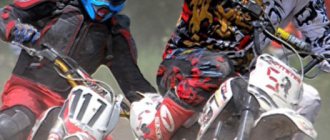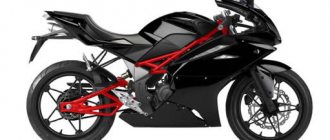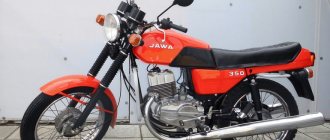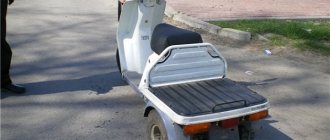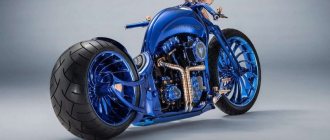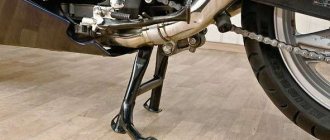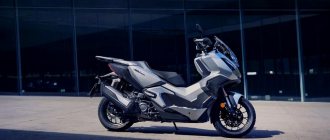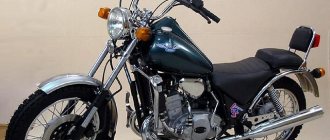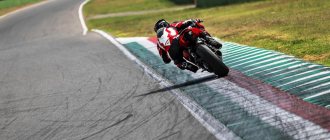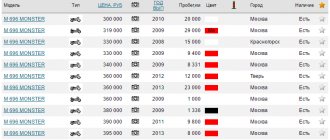Touring BMW F750GS
After the first 20 minutes on it, my partner stuck an action camera in my face and asked about my impressions of the BMW F750GS. I honestly said that I hate him. But before you misunderstand me, let me tell you the circumstances under which everything happened.
Touring BMW F750GS
We stood on the side of a river of liquid mud, which, by misunderstanding, is considered a road. The river-road went down the hill. We were riding a pair of BMW F750GS with road tires and no crash protection of any kind. Moreover, we stopped to rest on the only dry spot in the area, and it was dry only because it consisted of sand. In short, we were not in the most suitable conditions for the “most expensive goose”.
The BMW lineup already has one similar touring motorcycle of similar capacity - the BMW F850GS. Moreover, their engines are the same - 853 cc in-line twins, although the BMW F750GS engine is tuned differently and produces less thrust. Different camshafts, intake tracts and ECUs result in the 750 producing 77 hp. at 7500 rpm and 82 Nm at 6000 rpm, in contrast to the characteristics of the 850, which are 90 horses and 85 Nm.
In its basic form, the BMW F750GS is equipped with ABS, traction control (ASC) and two driving modes: Rain and Road. The main difference is the presence in the advanced version of an inertia measurement device, thanks to which the angle of inclination will be taken into account when calculating the response parameters of ABS and traction control. The bikes we rode were additionally equipped with electronic dynamic rear suspension control, which automatically adjusts damping according to data from an inertia measuring device.
Also, the Select Package on the BMW F750GS includes the same advanced LCD instrument cluster and professional riding modes, including Dynamic and Enduro, as on the F850GS. Each ride mode changes throttle response and affects settings for ABS Pro, Dynamic Traction Control, Dynamic Rear Suspension Tuning, Cruise Control and Tire Pressure Monitoring. The biggest difference between the F750GS and the 850 is the lack of an Enduro Pro riding mode. However, the best mode on it is Dynamic, regardless of the road condition.
In this mode, the response to the throttle becomes as sharp and aggressive as possible. However, not as aggressive as on the 850k. BMW really tried to make the 750 softer and smooth out the harshness of the throttle. Some people will like it, while others will want more harsh behavior.
The 750ki's suspension is significantly different from the 850. The fork is a regular 41mm telescopic with 150mm of travel (that's about a quarter less than on the F850GS). Where they are similar is the lack of fork settings.
The rear shock absorber here has a classic design (the 850 has a WAD shock absorber with progressive damping). In its basic form, shock absorber preload is manually adjusted via a hydraulic system, as is rebound damping. By upgrading to the Premium Package, you get Dynamic ESA electronic suspension control, which allows you to adjust the suspension using buttons. Rear suspension travel is 175 mm, which is about 4 centimeters less than on the F850GS.
The ground clearance of 19 centimeters has been reduced by about 5 centimeters compared to the F850GS. This mainly worked to the benefit of the model, making it one of the most comfortable saddles for short riders on the touring market. The stock seat height has been reduced by 5 mm compared to the previous F700GS to 81.5 cm. A lowered seat and lowered suspension are available in the accessories catalog, allowing the overall seat height to be reduced to 77 cm.
A fully charged device weighs 223 kg, which is 5 kg lighter than the F850GS.
The BMW F750GS brake system from Brembo remains the same, but it is installed on different wheels. While the larger, more off-road F850GS has spoked wheels, the 750 uses alloy wheels. The rear tire size on both bikes is 150/70R17, while the front tire on the 750 has a more street size 110/80R19. My example had Bridgestone Battlax Adventure A41s, good road tires, but not the best for mud and sand.
Now it's time for us to go back to the beginning...
When comparing equipment of the same class, it’s always great to be able to change from one bike to another when your butt has not yet lost the shape of the seat of the previous motorcycle. This is an ideal situation. It didn’t work out that way for me and several days passed after the KTM 790 Adventure. Unfortunately, I didn’t get the BMW F850GS; it wasn’t on the test, but its younger brother, the F750GS, spent the next three days with me. After this test, I was even more interested in trying the 850 version, since almost the smallest gosling (don't forget about the 310GS) made a good impression. A luxurious TFT display, mountains of information, including even tire pressure - this is something you don’t expect to see in such a segment. Yes, I had to play around with the navigation and need to get used to it, and the navigation wheel is an interesting thing, but only because of it, to turn on the turns, you need to take your hand off the steering wheel more significantly than we usually do on a motorcycle. By the way, oddly enough, with all these progressive things, I still haven’t come across remote controls that are more convenient and intuitive than those on my 1992 BMW. and have not yet found an explanation for this phenomenon.
The next thing I would like to note is the seat. I don’t know what the Bavarians are doing with this part of their GS, but even the most fierce haters of the “blue and white” admit that in terms of fit and comfort, it’s difficult to compete with the “geese”. The engine creates pleasant vibrations, but at first leaves a double impression. It pulls well from the bottom, is not hysterical, but at low speeds (up to 2000) it twitches and hints at the ability to stall. I was tempted to raise the idle, but there is no such option on the F750GS. Due to this behavior of the engine, in the same traffic jams and stretches I had to work more with the clutch. It would seem like an unpleasant thing, and yet, it was the motorcycle engine that I liked the most, to the point that I agreed to forgive the lower parts. An unexpected bonus was the stock exhaust, whose pleasant sound gave the impression that it was not at all factory. I can imagine what can be achieved by playing around with third party manufacturers.
For some, the lack of a windshield will be a disadvantage. This is probably a fair point, although given the cannibalism of the F750GS in relation to the F800R, it becomes clear that the “gooseneck” is more of a street version with the ability to go off-road, so its owners will not necessarily need wind protection (as a naked bike enthusiast, I find the lack of it generally didn't bother me). Alloy wheels provide fairly sharp steering in the city, you can play with driving modes on the go, and the “Brembo” inscription guarantees predictable braking. The passenger also noted the softness of the seat and sufficient comfort during city driving.
Oh yes, the tank is in its usual place and at the gas station there is no need to bother with which side to approach the pistols from. For three days, mostly in cities, with occasional traffic, a consumption of 4.2 l/100 km was recorded on the dashboard. Despite the fact that these are not exactly my type of motorcycles, I found myself feeling a pleasant anticipation in the morning at the prospect of the upcoming ride.
Riding a BMW F750GS
In general, the F850FS and F750GS were tested simultaneously. I was hoping to ride the more capable F850GS somewhere far from civilization and assumed that the F750GS "road SUV" would be tested somewhere on not so good asphalt. I was wrong.
After 5 minutes of riding, we found ourselves on a muddy dirt road along which we climbed to the mountain plateaus. When I said I hated my bike, I meant that I really didn't like riding through the mud on road tires that were loaded with regular road pressure.
BMW says the F750GS rims are strengthened compared to the F700GS wheels. Despite this, it took me an hour to bend the front wheel.
The first half of our trip was spent chasing each other along compacted dirt roads. My partner, an off-duty owner of a 2012 Tiger 800, quickly got used to the geometry of his bike and the size of its wheels and was doing well to catch up with the BMW representative on his R1200GS Rallye. For us with the 750m, the front end felt heavy and unstable and I had to use my whole body to steer it where I wanted it to go.
At first I tried riding in Enduro mode, but I soon realized that in this mode the motorcycle behaves constrained. I turned off the traction control completely and turned on Dynamic mode, which makes the engine respond much more aggressively to the throttle. That helped. But there was still a struggle with the paws of the gearbox and rear brake: I couldn’t reach them. I encountered the same problem on the F850GS.
But as soon as we hit the melting hot asphalt, the touring BMW F750GS was in its element. I was amazed at how stable it was, like a glove, at considerable highway speeds. At some point, I looked at the speedometer and saw that we were exceeding 160 km/h, but it felt like a little over a hundred. I think it was in such conditions that the shorter travel suspension and tire model determined its behavior and clear advantage over the F850GS. Perhaps the F850GS would also perform well on road tires, but then it would not be at all happy on the off-road.
The BMW F750GS motorcycle felt extremely friendly. I could easily reach the asphalt with my feet, while I felt spacious and comfortable. The electronics worked flawlessly, the huge LCD panel is easy to read, and the electronic suspension works great. While I wouldn't mind tuning the fork, I was surprised at how well it performed stock.
The only thing I don’t understand is why BMW decided to choke this engine. Without comparison, the F750GS does not feel stunted, but we just compared them, and the difference in response with the 850 model is immediately felt.
Perhaps it would make more sense to follow Triumph's path with its Tiger 800 touring enduro. Just as the Tiger 800 XR is a more street-friendly midsize bike, the F750GS is the same in BMW's line-up. A road warrior doesn't need to reduce power to perform better, and Triumph understands this very well by giving the Tiger 800 XR and 800 XC the same engine.
Review of BMW F700GS, F800GS and R1200GS from RMT based on the results of 2 million kilometers on tours
If we calculate how much we have traveled on our motorcycles in total over the past years, we get some crazy figure, about 1.5 million kilometers. It’s unlikely that anyone else in Russia has such experience in operating a BMW GS in one hand.
Today we will talk about those motorcycles that have proven themselves - F700GS, F800GS, R1200GS. We’ll tell you about the new “fifties” (F750GS, F850GS, F1250GS) later; it’s too early to do a full review.
Let's start with the younger models.
BMW F700GS – a motorcycle for all occasions
The F700GS appeared in 2012, replacing the F650GS. It was a logical addition to the F800GS as a bike more aimed at asphalt, beginners and short people.
The main purpose of the F700GS is asphalt touring, and here it has many strengths. The suspension and wheels of the F700GS are adapted specifically for road driving. The suspension travel is less than on the F800GS, and the front wheel has a smaller diameter. On asphalt, all this is an advantage, not a disadvantage, because the stiffer suspension improves handling, and the 19-inch front wheel has a larger contact patch with the asphalt than the 21st on the F800GS.
F700GS are suitable for trips of any length, and regularly travel on the Trans-Siberian Railway, traveling ten thousand kilometers without any problems.
With the F700GS off-road, things are not so simple. Here the suspension works noticeably worse than that of the F800GS, and the position in the rack is not very comfortable. One could say that this motorcycle is poorly suited for dirt, if not for one BUT. In our practice, there are many cases when these bikes participated in dirt tours, and passed all the tests with honor.
The most striking achievement is that the F700GS reached Magadan. This reminds us once again that riding skills take precedence over motorcycle choice, and the best off-road tuning is training and ability to ride on dirt.
The target audience of the BMW F700GS is wider than it might seem at first glance. This is the only goose with a low rise, so it is loved by people of shorter than average height. Quiet dynamics and good brakes are great for beginners, this bike is ideal as a first motorcycle.
And most importantly, the small goose is suitable for everyone who is not chasing “top performance”, excess power and the ability to drive 120+ km/h. That's why it has become very popular on our tours.
When an experienced motorcyclist from Canada comes to us, with more than 30 years of experience driving a motorcycle, he does not need to prove anything to anyone; he will be quite satisfied with a simple and reliable gooseneck.
The F700GS's strength is its reliability. Clutch, bearings, everything lasts longer than on the F800GS. In addition, cast wheels allow the installation of pressure sensors. By the way, casting does not create problems here. The motorcycle itself is light, and the rubber profile is “thick”, so the rims very rarely bend (unlike the 1200, but more on that below).
Summary – The F700GS is a great bike for everyone for all occasions. On the Russian market it is undervalued, it is overshadowed by brighter and more powerful motorcycles, with many electronic special features, but this is a purely psychological effect. Our summary is that this motorcycle will take you anywhere in the world, wherever you go, even around the world.
BMW F800GS – universal touring enduro
The F800GS has been in mass production since 2008. During this time, it went through several significant updates, but its very essence did not change. Its main advantage is excellent off-road performance, despite the fact that it also performs well on asphalt. The real golden mean.
The motorcycle is powerful enough to feel comfortable on the road and travel any distance. At the same time, it has a long-travel suspension, a 21st front wheel and spokes. In total, this gives excellent off-road performance, especially if you choose the right tires.
The engine is “superior”, that is, it manifests itself at high speeds. Overtaking on the highway is excellent, but at low speeds there may not be enough traction, however, this is more a question of driving style. The brakes are not as perfect as on a boxer gooseneck, but are still very decent.
Of the shortcomings that personally hindered our lives, this is, firstly, tube tires. In theory, on difficult ground, this is good, it reduces the chance of getting a puncture, and if the disc is deformed, you can drive (if you puncture a cast disc, then there’s no way forward). But, on the other hand, this does not allow you to repair tires with harnesses and there is no pressure sensor in the wheels.
As a result, on several of our motorcycles we converted the wheels to tubeless ones, everything was ok.
The second drawback is that for us these motorcycles required more attention than the same 700s and 1200s. We regularly had to change the steering and wheel bearings; the clutch travels less than on 700s and 1200s, 30-40 thousand km instead of the expected 60-80 thousand km on other motorcycles.
The seals/boots leaked regularly. In addition, there were difficulties with the gearbox, but most likely this is a consequence of the human factor when driving.
In general, if we abstract from the little things, our conclusion based on the results of four years of operation of these motorcycles is that they are an excellent touring bike for any purpose, the main thing is to always have bearings and seals/boots with you, they are not expensive and this is not a difficult job. The motorcycle is good both on asphalt and on dirt, not too heavy, it is the perfect middle ground.
R1200GS – one love, one heart, one destiny. Flagship, beauty and our favorite
The history of the boxer Geese is the history of touring enduro motorcycles as a class. It was BMW that made the world's first touring enduro, the R 80 G/S, which saw the world in 1980.
Since then, BMW's off-road flagship, the boxer goose, has maintained the continuity of generations. Modern geese are the result of the continuous evolution of that first R 80 G/S, which in its time became a real breakthrough. This year, by the way, the GS series is 40 years old!!!
The R1200GS LC, which appeared on the market in 2013, became better than its predecessor, the air 1200, in many respects - lighter, more powerful, faster. On the other hand, compared to airborne ones, it has lost its reserve of “cast iron” super reliability. The water goose is still reliable, but without the “super” rating.
Until recently, there were 8-9 such motorcycles in our fleet, but last year we sold most of them and replaced them with 1250GS.
In four years, we have driven about 1 million km on them and we think we have experience that is worth sharing.
The main purpose of the R1200GS is asphalt tourism. Its strong point is that you will be happy to cover any distance on it, on any roads. The motorcycle has an excellent engine, brakes and suspension, ideal ergonomics, wide tires with a large contact patch, and reliable electronic assistants. He feels great on asphalt of any quality, this is his element. You can easily travel on it with a passenger.
The motorcycle is very powerful and gives amazing dynamics. The Water Goose has a lot of electronics, it is deeply integrated, and overall it does its job very well. Riding modes, traction control, and ABS are available here. In addition, electronic suspension is available as an option.
The electronics work well and don't cause any problems. Literally once we had a case where the throttle on the brand new 1200GS 2022 started to malfunction. This was solved by reflashing it under warranty, after which the problem no longer appeared; this did not happen on other motorcycles either.
The brakes, which were good on the air goose, became simply ideal on the water goose; it literally stops on the spot.
At the same time, the BMW R1200GS always has the opportunity to slide onto the ground. Not everyone understands why heavy touring enduros are needed and we see there are extremes, some are eager to ride it to Magadan or Mongolia, others argue that this is an exclusively asphalt motorcycle that only pretends to be an SUV, and it is not possible to move off a hard surface on it. more than a marketing fantasy of the Bavarians.
In our opinion, the truth is approximately in the middle.
Everything is clear with asphalt, this is the element of the R1200GS. With off-road travel, everything is a little less clear. On hard ground this bike feels great; in such conditions the weight is compensated by the low center of gravity due to the boxer engine.
But if you need to ride on difficult terrain: sand, mud, stones, steep descents and ascents, then the big goose noticeably loses ground compared to its younger brothers. Most importantly, it is noticeably heavier. Holding it can be difficult, especially at low speeds on slippery ground. And if you drop it, it will be difficult to pick it up. There is, however, one hidden advantage here. The cylinders sticking out in different directions prevent the motorcycle from falling horizontally; it always lies at an angle, which makes it easier to lift it.
Separately, it is worth noting the wheels and tires of the water goose. When creating it, BMW went towards improving asphalt characteristics, which is logical, since the main element of the big Goose is asphalt.
The width of the front tire is 110 mm, the rear one is 170 mm, which is significantly larger than on an air goose. The tires are wide and low profile. On the one hand, this gives even better performance on asphalt, allowing you to fully realize the potential of a powerful engine and effective brakes. On the other hand, this solution has two drawbacks.
First, low-profile tires are easier to break through on uneven surfaces. That's why we try to put spoked wheels on our motorcycles, rather than cast ones. Alloy wheels are easy to dent; this happens to us quite often, several times a season. You can’t let off the pressure on off-road driving.
The second, unobvious drawback is driving on the ground. All true enduros have very narrow tires. The idea is that on a difficult surface, such rubber passes the top layer of soil and engages with a harder surface in depth. The wider the rubber, the more difficult it is for this effect to occur.
In addition, the wider the tires, the greater the overturning moment is created when you run over an obstacle with one edge. Wider tires, larger leverage for applying force, larger torque that needs to be compensated.
However, all of the above is not a reason to abandon the off-road route. It will be more difficult for you than on the F800GS or F850GS, but if your skills allow it, you can handle it. From our experience, people have driven the R1200GS everywhere: Magadan, Altai, Abkhazia, Mongolia, etc.
As for technical reliability, we share our experience, we don’t know about others. Our motorcycles have traveled 60-80 thousand km each without any breakdowns at all. When we just started in 2016, we heard and read a lot of stories about BMWs being damaged and problems with the driveshaft. We don’t know about others, but during our entire operation we had the following breakdowns:
- On one motorcycle, the front shock absorber leaked after 25 thousand km, it was replaced under warranty
- On another motor, the electric glitched at 2-3 thousand km. throttle handle, replaced under warranty
- At 60-70 thousand km feathers started leaking on several motorcycles, one of these days we will take them to the dealer under warranty and replace them
- On one motorcycle, the cardan fell apart at 70 thousand km, we bought a donor for 30k. Taking into account the absence of the need to change and lubricate chains, replacing the cardan every 70-80 thousand km for 30 thousand rubles is more profitable than a chain
Otherwise, we didn’t have any serious problems with the motorcycles. Cardan, clutch, bearings - everything is ok. Every 10 thousand km oil and filter. Every 20 thousand km brake fluid, valve adjustment. Tires and pads are worn out.
Overall, if it weren’t for technological progress, the desire of our guests to try the new 1250GS and high mileage, we would have been riding these motorcycles for many more years.
The Water Goose is our favorite and is a beautiful bike. It lost its stock of “cast iron” reliability, but acquired many other advantages. It performs perfectly on asphalt; for long journeys, like the Trans-Siberian Railway, it is the best choice. At the same time, it is good on the ground, even if in some places it is not very convenient.
If you have questions or comments, you can discuss them with us on the RMT Telegram channel, add yourself via the link - https://t.me/rusmototravel_public
Good luck to everyone and see you on the roads!
